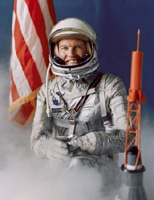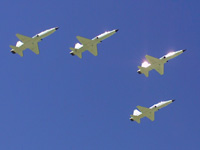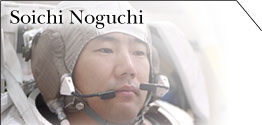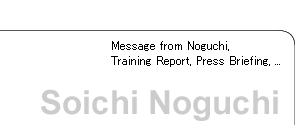Astronaut Noguchi's Training Report for STS-114 Mission, #14
The Fall of the Giant Star. -The Death of Mr. Gordon Cooper, One of the First Astronauts and One of the "Original Seven"
Last Updated: March 16, 2005
On October 4th, 2004 , Mr. Gordon Cooper, a retired Astronaut, had passed away. He was 77. I'd like to give Mr. Cooper's history and talk about his memorial service for this month's report.
The "Original Seven": The Age When Astronauts Were True Heroes
 |
| Mr. Gordon Cooper |
Mr. Gordon Cooper was one of the first astronauts selected by the U.S. for the Mercury Project, which was the U.S.'s first manned spaceflight program. The Mercury Seven were Deke Slayton, Alan Shepard, Gus Grissom, John Glenn, Scott Carpenter, Wally Schirra and Gordon Cooper. Together these astronauts were later known as the "Original Seven". Mr. Cooper was the youngest of the "Original Seven".
The Mercury astronauts were selected in 1959, when the United States was in the midst of the Cold War with the Soviet Union. The seven astronauts were the stars of the Mercury Project. This was the project where the United States was challenged, with its dignity at stake, by the Sputnik satellite launched by the Soviet Union. It can be said that this was the dawn of space exploration. That this was the time where the test pilots intrepidly challenged the technology that had never been tested before. The astronauts were the true heroes and true explorers. With Mr. Cooper's death, Mr. Schirra, Mr. Glenn and Mr. Carpenter are the last three members of the Mercury astronauts that are still alive.
Have you ever seen the movie "The Right Stuff"? This movie described the first human supersonic flight, the Sputnik Shock, and the success of the Mercury Project. This movie has been my favorite movie, and I have watched it over and over again since I was a high school student. The astronaut who flew on the Mercury Faith 7 during the last part of the movie was Mr. Cooper. This flight was the last flight of the Mercury Project and it was also the last solo U.S. manned space flight. (Gemini was a two-man space flight program and the Apollo was a three-man space flight program .) In the movie, Mr. Cooper was described as a lovable guy who had fallen asleep in the seat of his space craft before launch. In reality, he was a "born to fly" type of guy. A merry and wild pilot also known as a "Hot-Dog". (You can see a lot of these types of scenes in The Right Stuff".) Perhaps he was just valuing his good old fly-boy spirits. On the Faith 7 flight which I had previously mentioned, Mr. Cooper was the first astronaut to have slept in space. Mr. Cooper retired from NASA in 1970, but his passion for flying never died. When he was 70 years old, he was known to have said, "I get cranky if I don't fly at least three times a month." He also put significant personal effort in founding the Astronaut Scholarship Foundation in Florida, which supports youngsters who wish to pursue a career in space engineering.
Mr. Cooper also believed in the importance of space exploration development, not by the government, but by the private sector.
Two years ago, Mr. Cooper said "Airplanes were not developed by the government, it was developed by money put up by private citizens to win prizes, maybe we need something along the same lines in space,"
It was such a mysterious coincidence that on the very same day of Mr. Cooper's death, the SpaceShipOne, the first privately built space ship, made its prize winning successful flight. This could possibly mean that his spirits were successfully handed down to the next generation of manned space flight.
Memorial Service and Fly-By at Houston
Mr. Gordon Cooper's Memorial Service took place at the Johnson Space Center on October 15th. The highlight of the service was a Fly-By by four squadrons of T-38 aircrafts after the ceremony was held in a hall. The Fly-By is a special flight to honor the deceased pilot. During the ceremony, a four plane "Missing Man formation", flew low over the site of the service with one of the planes soaring up in the sky to represent the passing of Mr. Cooper. It can be said that the soul of the deceased was drawn up to heaven as the rest of us watched his departure.
 |
| T-38 jets in a Fly-By |
Astronaut Wakata and I participated in the formation flight. We were used to flying the T-38, but we did not have a lot of experience in flying in a four plane formation. Not only that, but we were flying extremely close to the ground, and we had to fly over the site exactly on schedule during the service. We took extra care during our preparation for the flight. On the day of the service, five T-38 aircrafts (one plane on stand by) were prepared. The pilots went through a final and through meeting two hours before the fly-over. After we took off, we circled and waited in a nearby airspace about 10km from the site. Once the ground informed us that it was time to go, the four of us flew in a precise formation towards the site at an altitude of 500ft (150m) and at a speed of 300knots (580km/h). The sensation of speed created a feeling of scraping the roofs of the buildings and the fact that the other planes in the formation are just a few meters from mine made the adrenalin flow through my bo dy. It was something you could not get in training. The scenery on the ground was passing by with the extreme velocity, but our four T-38's were flying together very closely and we flew in silence. It was a very subtle balance between stillness and motion during the moment that we passed over the site. Our four T-38's, which were flying together, were like one as if we were pinned together until one of us soared up into the sky. It was as if a invisible hand appeared from the sky and scooped the plane up. As I flew, a scene from the movie "Kurenai no Buta (Porco Rosso)", by Mr. Miyazaki Hayao, flashed in my head. It was the scene where Porco's friends, who had died during an air battle, rose up into the clouds. You may think it was not a proper thing to do during an important mission, but for several-hundredths of a second, I could visualize that scene from the movie as it overlapped what I was actually seeing while flying.
It was such an honor for us to have not just one but two Japanese astronauts to have taken part in this Fly-By.
I was wondering if Mr. Cooper was pleased with us helping in his "Final Flight": Astronaut Wakata was born in the year Mr. Cooper made his first flight on Faith7 and I was born in the year he made his second flight on Gemini 5.
1957 October 4 Soviet Union successfully launched Sputnik, the world's first artificial satellite.
2004 October 4 Mr. Gordon Cooper died.
2004 October 4 The first privately built SpaceShipOne succeed in its second flight and thus captured the X-Prize.
October, 2004 From Houston





